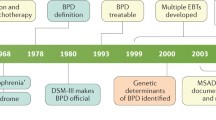Abstract
Key principles of inpatient management of borderline personality disorder (BPD) are consistent with many basic lessons from other levels of care. First, it is important to hospitalize reluctantly, differentiating nonlethal from true suicidal intent and searching for the least restrictive safe option. Decision to hospitalize should ideally involve the patient (clearly presenting risk of destabilization) and outpatient team. When hospitalization is recommended, shorter stays are almost always preferable to longer term, which may easily become regressive. It can be helpful to point out the unconscious desire to be cared for, in the safety provided by the structured holding environment. Taking responsibility for patients' needs in times of crisis may inadvertently undermine their capacity to care for themselves. The goals may include keeping the patient safe, exploring incident antecedents, providing education, evaluating current treatment (approach as well as medication regimen), planning transition to aftercare, and including the patient and family in the various steps. Challenges often present themselves around team splitting, family contact, and increasing anxiety while approaching discharge. Helping patients modulate emotions through this process should aim at generalizing behaviors they can use outside of the hospital.
Access this chapter
Tax calculation will be finalised at checkout
Purchases are for personal use only
Similar content being viewed by others
Suggested Readings
Gunderson JG. Borderline personality disorder a clinical guide. Washington, DC: American Psychiatric Publishing; 2008.
Gunderson JG. Handbook of good psychiatric management for borderline personality disorder. 2014. Washington, DC: American Psychiatric Publishing; 2008.
Miller LJ. Inpatient management of borderline personality disorder: a review and update. J Personal Disord. 1989;3(2):122–34.
The NICE guideline on treatment & management: borderline personality disorder. National Collaborating Centre for Mental Health: The British Psychological Society and The Royal College of Psychiatrists, 2009. https://www.nice.org.uk/guidance/cg78. Accessed 6/23/18.
Practice guidelines for the treatment of patients with borderline personality disorder. American Psychiatric Association. 2001, 2010.
Author information
Authors and Affiliations
Corresponding author
Editor information
Editors and Affiliations
Rights and permissions
Copyright information
© 2018 Springer International Publishing AG, part of Springer Nature
About this chapter
Cite this chapter
Saliba, Z. (2018). Inpatient Psychiatric Management. In: Palmer, B., Unruh, B. (eds) Borderline Personality Disorder. Springer, Cham. https://doi.org/10.1007/978-3-319-90743-7_7
Download citation
DOI: https://doi.org/10.1007/978-3-319-90743-7_7
Published:
Publisher Name: Springer, Cham
Print ISBN: 978-3-319-90742-0
Online ISBN: 978-3-319-90743-7
eBook Packages: MedicineMedicine (R0)



